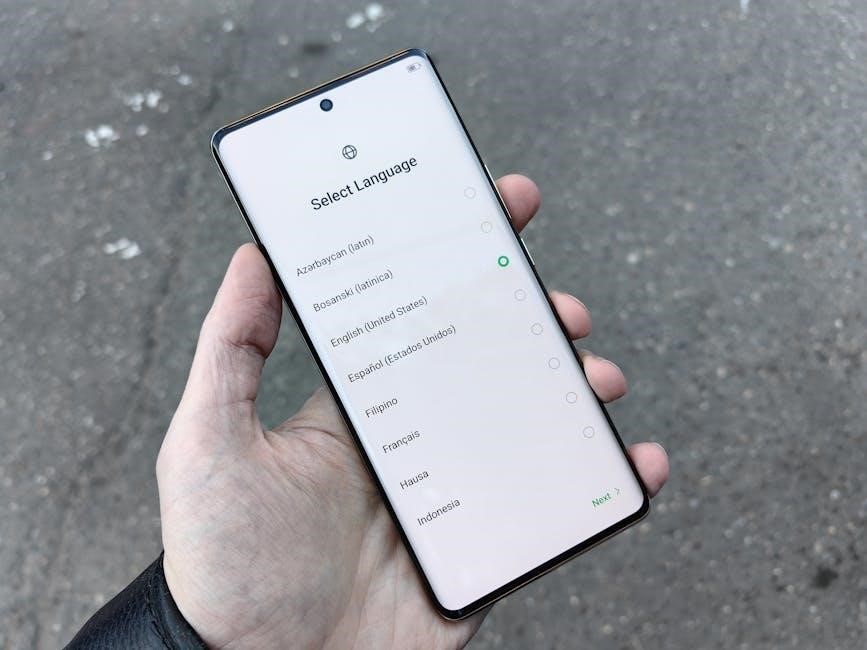manual de manejo de carolina del norte en espanol

Welcome to the North Carolina Driving Manual in Spanish, a essential guide for Spanish-speaking drivers․ This manual provides clear, accessible information to ensure safe and lawful driving in North Carolina․

1․1 Importance of the Manual for Spanish-Speaking Drivers
The North Carolina Driving Manual in Spanish is a crucial resource for Spanish-speaking drivers, ensuring they understand traffic laws and safe driving practices․ It provides accessible information in their native language, improving comprehension and adherence to road safety․ This manual is particularly valuable for new residents or learners, as it bridges language gaps and fosters confident, lawful driving․ By offering clear guidelines tailored to North Carolina’s specific regulations, it promotes safer roads and helps drivers navigate the state’s unique driving conditions effectively․ The manual’s availability in Spanish underscores the importance of inclusivity in driver education, making it an indispensable tool for Spanish-speaking individuals seeking to drive responsibly in North Carolina․
1․2 Overview of the Manual’s Structure
The North Carolina Driving Manual in Spanish is organized into clear, logical sections to facilitate easy understanding․ It begins with an introduction to the manual’s purpose and structure․ Subsequent chapters cover essential topics such as driver’s licenses, traffic laws, safe driving practices, road signs, and special driving situations․ Each section is designed to address specific aspects of driving in North Carolina, ensuring comprehensive coverage of all necessary information․ The manual also includes visual aids like diagrams and examples to clarify complex concepts․ By following this structured approach, Spanish-speaking drivers can navigate the manual effortlessly, gaining the knowledge and confidence needed to drive safely and responsibly in North Carolina․
1․3 Benefits of Learning Traffic Laws in Spanish
Learning traffic laws in Spanish offers numerous benefits for Spanish-speaking drivers in North Carolina․ It enhances understanding of local regulations, reducing the risk of violations and ensuring safer roads․ By familiarizing themselves with specific terms and concepts, drivers can make informed decisions behind the wheel․ This knowledge also fosters confidence and independence, allowing drivers to navigate the state’s roadways with ease․ Additionally, understanding traffic laws in Spanish helps drivers communicate more effectively with law enforcement and other road users․ Overall, this proficiency contributes to a safer, more compliant driving community, aligning with North Carolina’s commitment to road safety for all residents․

Driver’s Licenses in North Carolina
Obtaining a driver’s license in North Carolina is essential for legal driving․ The process involves specific requirements and tests, ensuring road safety and compliance with state laws․
2․1 Types of Driver’s Licenses Available
In North Carolina, various driver’s licenses are available to meet different needs․ These include adult licenses for drivers aged 18 and above, young adult licenses for those under 18, and commercial licenses for professional drivers․ Additionally, restricted licenses may be issued under specific conditions․ Each license type has distinct requirements and privileges․ The REAL ID-compliant license is also an option, meeting federal security standards for domestic travel․ Applicants must provide necessary documentation, such as proof of identity, residency, and legal status․ Vision tests and written exams are typically required․ Understanding the differences and eligibility criteria is crucial for selecting the appropriate license․ Applications and detailed information are available at local DMV offices or online․
2․2 Requirements for Obtaining a Driver’s License
To obtain a driver’s license in North Carolina, applicants must meet specific requirements․ These include providing proof of identity, residency, and legal status․ A valid Social Security number is also mandatory․ Vision tests and written exams are typically required to assess driving knowledge and visual acuity․ For minors under 18, parental consent is necessary, and they may need to complete a driver’s education course․ Applicants must submit the required forms and fees at a local DMV office․ Additional documentation may be needed for certain cases, such as name changes or immigration status․ It is essential to review the latest requirements before applying to ensure a smooth process․ For detailed information, visit the North Carolina DMV website or consult their offices directly․
2․3 Renewal and Replacement Process
In North Carolina, driver’s license renewal can be done online, by mail, or in person at a local DMV office․ Applicants must provide proof of identity and residency․ For online renewals, a valid credit card is required for the fee․ In-person renewals may require a vision test․ If your license is lost or stolen, you can request a replacement by submitting form DL-101 and paying the replacement fee․ You must also provide identification and proof of residency․ For convenience, some services may be available at NCDMV Express offices․ It’s important to keep your license up to date to maintain legal driving privileges․ Always check the NCDMV website for the most current requirements and any additional documentation needed․

Traffic Laws and Regulations
Understanding North Carolina’s traffic laws is crucial for safe driving․ Key regulations include speed limits, seat belt requirements, and DUI laws․ Drivers must obey right-of-way rules and school zone signage․ Violations result in penalties․
3․1 Speed Limits and Enforcement
Speed limits in North Carolina are designed to ensure safety on the roads․ Urban areas typically have a maximum speed limit of 55 mph, while rural highways may allow up to 70 mph․ School zones and construction areas have reduced speed limits, often 35 mph or lower․ Enforcement is carried out by state and local police, who use radar guns and traffic cameras to monitor compliance․ Drivers exceeding the speed limit face fines, increased insurance costs, and potential license penalties․ It is crucial to adhere to posted limits, as speeding is a leading cause of accidents․ Always adjust your speed according to road conditions and visibility to maintain safety for yourself and others․
3․2 Seat Belt and Child Safety Laws
In North Carolina, seat belts are mandatory for all drivers and passengers․ Children under 8 years old or weighing less than 80 pounds must use a properly secured child safety seat․ Rear-facing seats are required for infants under 2 years or 35 pounds; Booster seats are necessary until a child is 8 years old or 4 feet 9 inches tall․ Exceptions apply only for vehicles made before 1967․ Law enforcement strictly enforces these regulations, and violations result in fines․ Ensuring proper restraint use significantly reduces the risk of injury or fatality in accidents․ Compliance with these laws is essential for protecting all occupants and avoiding legal consequences․ Always prioritize safety by following these guidelines․
3․3 Driving Under the Influence (DUI) Laws
In North Carolina, driving under the influence (DUI) is strictly prohibited․ The legal blood alcohol concentration (BAC) limit is 0․08%․ Penalties include fines, license suspension, and mandatory alcohol education programs․ Commercial drivers face stricter limits, with a BAC threshold of 0․04%․ Underage drivers are subject to a zero-tolerance policy, with any detectable alcohol leading to penalties․ Repeat offenses result in harsher consequences, including ignition interlock devices․ Law enforcement actively enforces these laws to protect public safety․ Adhering to DUI laws is crucial to avoid legal repercussions and ensure the safety of all road users․

Safe Driving Practices
Safe driving practices emphasize maintaining a safe distance, using turn signals, avoiding distractions, and adhering to speed limits․ Stay alert, check mirrors, and be courteous to others․
4․1 Defensive Driving Techniques
Defensive driving techniques are crucial for minimizing risks on the road․ Anticipate others’ actions, maintain a safe distance, and stay alert to potential hazards․ Avoid distractions like using phones․ Be prepared to react to sudden stops or swerving vehicles․ Always check mirrors and blind spots before changing lanes․ Use signals consistently to communicate your intentions․ Adapt speed according to road conditions, slowing down in rain, fog, or heavy traffic․ Keep an eye on pedestrians and cyclists, yielding when necessary․ Defensive driving fosters a safer environment for everyone on the road, reducing the likelihood of accidents and ensuring compliance with traffic laws․
4․2 Sharing the Road with Pedestrians and Cyclists
Sharing the road with pedestrians and cyclists requires heightened awareness and courtesy․ Always yield to pedestrians at crosswalks and intersections, as they have the right-of-way․ When approaching cyclists, maintain a safe distance and never pass recklessly․ Use turn signals to indicate your intentions, allowing cyclists and pedestrians to anticipate your movements․ Be especially cautious in areas with heavy foot traffic or designated bike lanes․ Avoid distractions like using your phone, as this can lead to accidents․ Respect shared paths and reduce speed in areas where pedestrians and cyclists are present․ By fostering a cooperative driving environment, you contribute to safer roads for everyone․
4․3 Handling Emergency Situations
In case of an emergency, remain calm and act decisively․ If your vehicle breaks down, move to a safe location, such as the shoulder, and turn on hazard lights․ For accidents, check for injuries, call 911, and exchange information with others involved․ Never leave the scene without reporting it․ If you encounter a medical emergency, pull over safely and seek help immediately․ In foggy conditions, reduce speed and use low beams․ Always carry an emergency kit with essentials like a flashlight, first aid kit, and water․ Familiarize yourself with North Carolina’s emergency protocols to handle unexpected situations effectively․ Preparedness and quick thinking are key to staying safe on the road․

Road Signs and Markings
Welcome to the section on road signs and markings․ This part is crucial for safe navigation․ Learn about the purpose, types, and correct interpretation of traffic signs and pavement markings to ensure compliance with traffic laws and prevent accidents․ Familiarize yourself with these essential elements to enhance your driving skills and safety on North Carolina roads․
5․1 Types of Traffic Signs
Traffic signs are essential for guiding drivers and ensuring road safety․ They are categorized into three main types: regulatory, warning, and guide signs․ Regulatory signs, such as stop signs and speed limit signs, enforce traffic laws and inform drivers of specific rules․ Warning signs, like curve ahead or pedestrian crossing signs, alert drivers to potential hazards․ Guide signs provide directional or informational content to help drivers navigate roads and locate destinations․ Understanding these categories helps drivers recognize and respond appropriately to the information conveyed by each sign, enhancing overall safety on the road․ This section will detail each type, helping Spanish-speaking drivers in North Carolina to better comprehend traffic signage․
5․2 Warning Signs and Their Meanings
Warning signs are critical for alerting drivers to potential hazards or changes in road conditions․ They are typically yellow or orange in color and feature distinctive shapes and symbols․ Common examples include “Curve Ahead,” “Pedestrian Crossing,” and “Merge Traffic Ahead․” These signs help drivers anticipate and prepare for situations that may require slowing down or adjusting their driving behavior․ For instance, a “School Zone” sign indicates a reduced speed limit and increased pedestrian activity․ Understanding the meanings of these signs is vital for maintaining safety on the road․ Spanish-speaking drivers in North Carolina will find these signs consistent with international standards, making them easier to recognize and interpret, even for those new to driving in the U․S․
5․3 Understanding Pavement Markings
Pavement markings are essential visual guides on the road surface that help drivers navigate safely and efficiently․ These markings include lines, arrows, and symbols that communicate important information․ Solid lines, for example, indicate where changing lanes is prohibited, while dashed lines suggest where lane changes are permitted․ Arrows guide traffic flow direction, and symbols like crosswalks or bike lane markings alert drivers to pedestrian or cyclist activity․ Understanding these markings is crucial for adhering to traffic laws and ensuring safety․ In North Carolina, these markings are consistent with national standards, making them easily recognizable for all drivers, including Spanish-speaking motorists who may be familiar with similar systems in their home countries․

Driving in Various Conditions
Mastering various driving conditions, such as rain, fog, or snow, is crucial for safe navigation․ Adapt your speed and techniques to match the environment and ensure visibility․

6․1 Driving in Rain and Wet Conditions
Driving in rain and wet conditions requires extra caution․ Reduce your speed to maintain control, as wet roads can cause hydroplaning․ Use low beam headlights to improve visibility without blinding others․ Avoid sudden movements and keep a safe distance from other vehicles․ Ensure your windshield wipers are in good condition for clear vision․ Be aware of standing water, which can hiding potholes or reduce traction․ If rain is heavy, consider pulling over until conditions improve․ Always wear your seatbelt and stay alert for pedestrians or cyclists, who may be less visible in poor weather․ Proper tire maintenance is crucial to prevent skidding on wet surfaces․
6․2 Navigating Fog and Low Visibility
Driving in fog or low visibility requires extreme caution․ Reduce your speed significantly and use low beam headlights to avoid reflecting light back into the fog․ Avoid sudden movements or braking, as visibility is limited․ Maintain a safe distance from other vehicles to allow more time to react․ If fog is extremely dense, consider pulling over to a safe location until conditions improve․ Keep your windshield wipers and defroster on to maintain a clear view․ Stay calm and avoid distractions while driving․ Always keep your headlights on, even during the day, to increase your vehicle’s visibility to others․ Be aware of pedestrians or cyclists, who may be harder to see in low visibility․ Follow all traffic laws and use GPS cautiously, as fog can disorient drivers․
6․3 Winter Driving and Snow Conditions
Winter driving in North Carolina requires special precautions due to snow and icy conditions․ Always check your vehicle’s tire pressure, as cold temperatures can reduce it, and consider using snow tires for better traction․ Reduce your speed significantly and increase the distance between you and the vehicle ahead․ Use low beam headlights to improve visibility and avoid sudden acceleration or braking, as this can cause skidding․ Keep an emergency kit in your car, including a blanket, flashlight, and ice scraper․ If your vehicle skids, stay calm and steer gently in the direction you want to go․ Bridges and overpasses freeze first, so approach them with extra caution․ If possible, avoid driving during heavy snowstorms and stay informed about road conditions before heading out․ Always keep your windshield and windows clear of snow and ice for optimal visibility․

Special Driving Situations
This section covers unique challenges, such as navigating roundabouts, driving in school zones, and understanding toll roads․ Stay alert and follow specific rules for each situation․
7․1 Negotiating Roundabouts Safely
Roundabouts are circular intersections designed to improve traffic flow and reduce accidents․ To navigate them safely, slow down before entering and yield to traffic already in the roundabout․ Always signal your intentions to exit, and stay in your lane․ Avoid stopping inside the roundabout unless necessary․ Be cautious of pedestrians and cyclists, and never bypass or cut across lanes․ Roundabouts require constant attention and adherence to traffic rules to ensure smooth and accident-free movement․ Always follow directional signs and pavement markings for guidance․ Remember, the key to safe navigation is patience and awareness of other drivers․
7․2 Driving in School Zones
Driving in school zones requires extra caution to protect children and pedestrians․ Speed limits in these areas are strictly enforced, typically reduced to 20-35 mph during school hours․ Always be alert for children crossing the street and follow all traffic signs and signals․ Never pass a stopped school bus with its stop arm extended, as this is illegal and dangerous․ Maintain a safe distance from other vehicles and avoid distractions like using your phone․ Be prepared to stop suddenly and yield to pedestrians at crosswalks․ Failing to adhere to school zone rules can result in severe penalties, including fines and license suspension․ Stay vigilant and prioritize safety to ensure the well-being of all children and drivers․
7․3 Understanding Toll Roads
Toll roads in North Carolina are designed to manage traffic flow and fund infrastructure improvements․ Drivers must pay a fee when using these roads, which can be paid with cash or electronic methods like E-ZPass․ The NC Quick Pass is the state’s electronic toll collection system, offering convenience and efficiency․ Toll rates vary depending on the road and the type of vehicle․ It’s important to follow posted signs indicating toll booths or electronic gantries․ Failure to pay tolls can result in fines or penalties․ For visitors, rental cars may automatically charge toll fees, so check with your rental company․ Always keep your toll receipts for records and reimbursement purposes if necessary․ Understanding toll roads helps ensure smooth travel and compliance with state regulations․

Resources and Support for Spanish-Speaking Drivers
Spanish-speaking drivers in North Carolina can access translated driving manuals, online resources, and community support․ Local driving schools and cultural adaptation guides are also available to assist newcomers․
8․1 Spanish Language Driving Resources
Spanish-speaking drivers in North Carolina can access a variety of resources to help them understand traffic laws and safe driving practices․ The North Carolina Driving Manual in Spanish is available online and in print, offering a comprehensive guide tailored to Spanish speakers․ Additionally, many driver education programs and community centers provide Spanish-language materials, including study guides for driver’s license tests․ Online platforms also offer interactive tools, such as practice tests and video tutorials, to assist learners․ These resources ensure that Spanish-speaking drivers have equal opportunities to gain the knowledge and skills needed to drive safely and legally in North Carolina․
8․2 Community Support and Driving Schools
Spanish-speaking drivers in North Carolina benefit from strong community support and specialized driving schools․ Many organizations offer free or low-cost resources, such as driving courses and study groups, to help learners prepare for the driver’s license exam․ Driving schools with bilingual instructors provide personalized instruction, ensuring students understand both the rules of the road and safe driving practices․ These programs often include practice tests, hands-on training, and guidance on navigating the legal requirements for obtaining a license․ Community centers also host workshops to address common challenges faced by Spanish-speaking drivers, fostering a supportive environment for learning and success․
8․3 Cultural Adaptation Tips for New Drivers
Cultural adaptation is key for Spanish-speaking drivers adjusting to North Carolina’s driving norms․ Understanding local traffic customs, such as merging etiquette and right-of-way rules, can enhance safety․ Language barriers may pose challenges, so familiarizing oneself with English traffic terms is crucial․ Differences in driving laws between the U․S․ and other countries should be noted, especially regarding speed limits and DUI regulations․ Engaging with local driving communities and seeking guidance from bilingual instructors can ease the transition․ Additionally, respecting diverse road conditions and weather-specific driving practices in North Carolina helps new drivers adapt effectively․ These tips foster confidence and ensure a smooth adjustment to driving in a new cultural environment․




